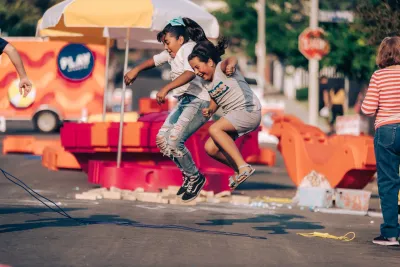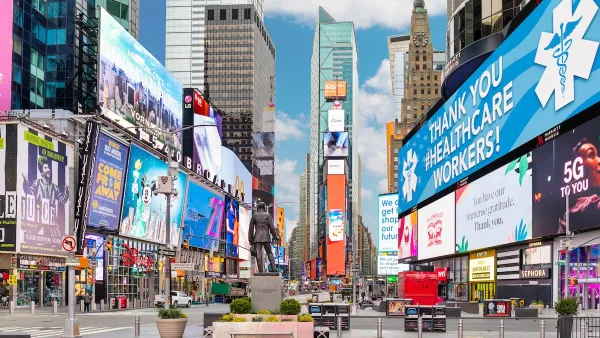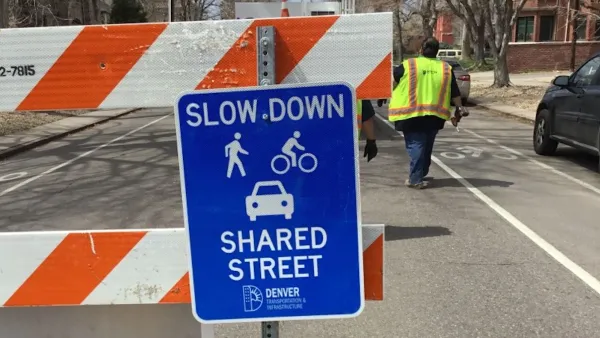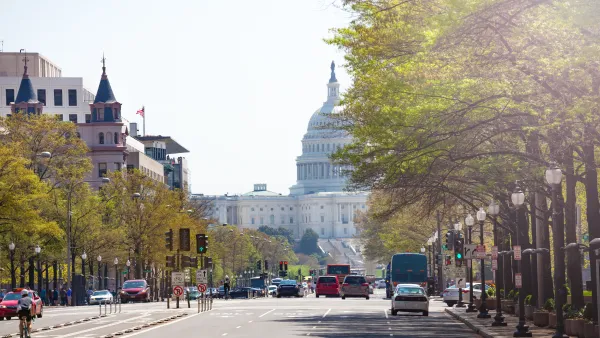'Playable' public spaces can be a powerful tool for creating vibrant, communal, and equitable cities.

The COVID-19 pandemic, writes Ryan Swanson, underscored "how much we value and need physical and social connection through spontaneous interactions, and it stripped us of the moments that once provided us with structured play, such as organized sports." Cities responded with open streets programs and outdoor dining which revealed the possibility for different uses of streets and sidewalks. But "to make our cities healthier and happier," we must take it a step further, argues Swanson, founder of Urban Conga, "a design studio that works with communities to weave spaces for play into the fabric of our cities." Swanson says play is not only "a necessary, universal, lifelong part of the human experience and helps us to discover, explore, and empathize with others," but also "a powerful tool to bridge divides and spark more equitable spaces in our built environment."
To this end, "[e]veryday public facilities — such as park benches, bus stops, street lights, fountains, or any number of other appurtenances — could become ‘PLAY’ces, platforms for open-ended play that provide inclusive, stimulating, creative outlets for communal connection." Such projects have been sporadically and spontaneously installed in U.S. cities, "but any truly effective movement to incorporate play into our public spaces would need the support from our city leaders, stakeholders, and policymakers."
The shift to including play as a critical aspect of urban infrastructure requires an acknowledgement of "its salutary effect on the health, identity, social, and economic value of our cities and communities. The idea that we need outdoor play spaces that can be used by people of all ages is all too often absent from discussions of urban-infrastructure development, public-space design, and city change." But, Swanson says, "open streets, parklets, and facilities for spontaneous play are key components for creating more healthier, equitable, social, and economical cities and neighborhoods" that are "adaptable and contextual" to their changing environment.
FULL STORY: OPINION: ‘Playable’ Cities Are the Next Public-Space Frontier

Analysis: Cybertruck Fatality Rate Far Exceeds That of Ford Pinto
The Tesla Cybertruck was recalled seven times last year.

National Parks Layoffs Will Cause Communities to Lose Billions
Thousands of essential park workers were laid off this week, just before the busy spring break season.

Retro-silient?: America’s First “Eco-burb,” The Woodlands Turns 50
A master-planned community north of Houston offers lessons on green infrastructure and resilient design, but falls short of its founder’s lofty affordability and walkability goals.

Test News Post 1
This is a summary

Analysis: Cybertruck Fatality Rate Far Exceeds That of Ford Pinto
The Tesla Cybertruck was recalled seven times last year.

Test News Headline 46
Test for the image on the front page.
Urban Design for Planners 1: Software Tools
This six-course series explores essential urban design concepts using open source software and equips planners with the tools they need to participate fully in the urban design process.
Planning for Universal Design
Learn the tools for implementing Universal Design in planning regulations.
EMC Planning Group, Inc.
Planetizen
Planetizen
Mpact (formerly Rail~Volution)
Great Falls Development Authority, Inc.
HUDs Office of Policy Development and Research
NYU Wagner Graduate School of Public Service




























